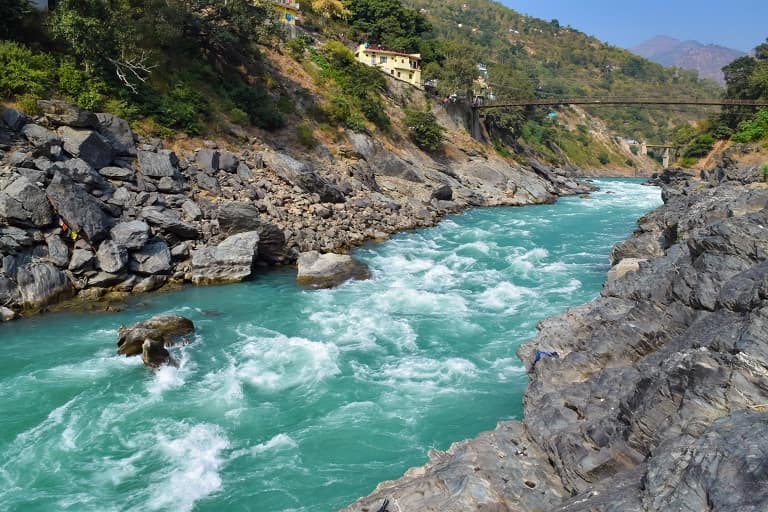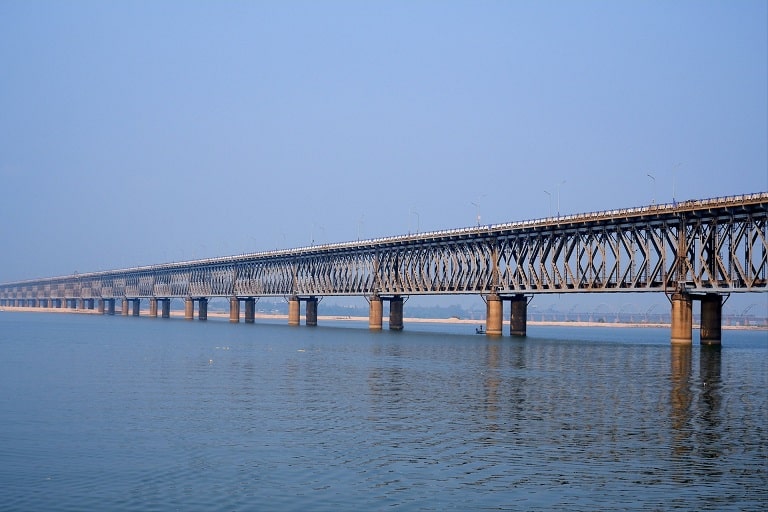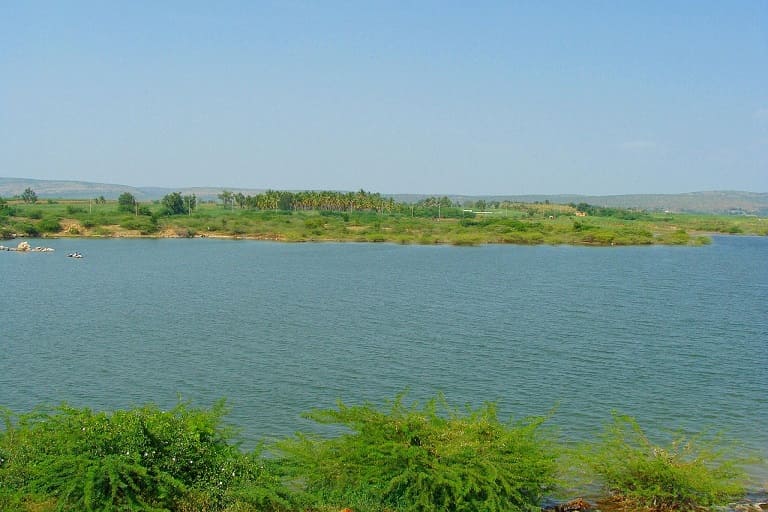India is such a country that has diversity in every aspect. The country has a very long and ancient history of civilization for centuries. But the civilizations wouldn’t be able to form if it wasn’t for the long rivers in India. The rivers, with their massive lengths and sustaining water bodies, have played a crucial role in shaping the history of India.
The India longest rivers are not only a source of water. They continue to be a means of inspiration, holiness and spirituality as well. If you want to witness the picture of real India, then you must see an integral part of the country’s rich heritage.
This article is all about the famous rivers in India. Read the article, and get ready to witness one or multiple outstanding rivers of the country.
1. The Ganges

The Ganges, often known as River Ganga, is among the most sacred rivers in India. With a length of approximately 2,510 km, the river flows through India and Bangalore before disappearing into the Bay of Bengal. The Ganges has tremendous religious, cultural and economic significance. Originating from the Gangotri Glacier in the Himalayas, the Ganga has been a significant part of India’s agriculture.
The River Ganga is not just another river, it has a deep spiritual connection with the people of India. According to the Hindu religion, all sins can be cleansed once bathed in the holy water of the Ganga. Millions of devotees gather on the river bank to get in touch with the epitome of holiness. Rituals, prayers, and ceremonies are held to pay homage to the Goddess Ganga.
However, the river is so much more than just the religious significance. It works as a lifeline for millions of people who live along the banks. To them, Ganga is the source of drinking water, agriculture, and water supply as well. Without the river, the ecosystem including the different birds, reptiles and fish would fall apart.
That said, the holiest river in India is not how it used to be. Over the years, pollution and degradation in the environment have threatened the existence of the river, including the inhabitants. Now the river is full of waste and unclean. Now though, actions are being taken to revive the river and restore the balance. The Indian Government has launched the ambitious Namami Gange program to rejuvenate the river.
The Ganges is not just a river, it is the soul of an entire nation. It is a symbol of the eternal flow of life that is never meant to end. It has captured the hearts of millions of Indians and left a mark on their hearts.
2. Godavari

Godavari is India’s one of the longest rivers that hold great significance. Stretching over a length of 1,465 km, the river Godavari originates from the Nashik district in Maharashtra. Then it flows there across six states in India, including Chhattisgarh, Maharashtra, Andhra Pradesh, Madhya Pradesh, Karnataka and Odisha. Eventually, like the Ganges, it disappears into the Bay of Bengal.
Since the river Godavari has immense significance in the Hindu religion, it is known as Dakshin Ganga or the “Ganges of the South”. Plenty of temples are located on the banks of this river, attracting worshippers from across the country. Throughout the years it has also witnessed many remarkable historical events including the rise and fall of multiple ancient kingdoms. You can still see the historical sites on the banks which will provide you with a glimpse into the past.
The Mangrove forests in the delta of the Godavari River are the reason behind the biodiversity and a suitable place for migratory birds. It also provides a water supply for the cultivation of essential crops like rice, cotton or sugarcane. Several dams have been constructed to regulate the flow of water.
However, like the Ganges, the river Godavari is not completely safe from danger. Pollution and overuse of water are some of the challenges that the river has to face. Efforts are now being made to solve these problems and ensure well maintenance of the river.
3. Krishna

The Krishna River is one of the major rivers in India. Originating from the Western Ghats near Mahabaleshwar and eventually entering into the Bay of Bengal. Spanning around 1,290 km, it flows through the states of Maharashtra, Karnataka, Telangana and Andhra Pradesh. Having a rich historical and cultural significance, it serves as a lifeline for the people living in its banks.
According to the legend, the river is the holy abode of none other than Lord Krishna. Krishna spent his childhood and performed many divine miracles in this place. It even has mentions in the epic like the Mahabharata. The city of Vijayawada in Andhra Pradesh is home to the Kanaka Durga temple located on the bank of the Krishna River.
The basin of the Krishna River is tremendously fertile. Thus, it plays a vital role in agriculture as well. It has been the lifeline for farmers for centuries now. The water of the river has been used in many ways including canals and dams to provide water for daily usage. The river basin also contains remarkably diverse wildlife. The Krishna Wildlife Sanctuary, located close to the river, is home to a variety of animals and birds.
However, Krishna River too, is not completely out of danger from domestic and industrial wastage. The water has become polluted affecting the ecological balance. Efforts are underway to conserve the river since it is the life source of millions of Indians.
4. Yamuna
Flowing through the northern state of Uttarakhand, Himachal Pradesh, Uttar Pradesh, Haryana and Delhi, the river Yamuna is one of the most important rivers in India. With a length of approximately 1,376 km, Yamuna is actually a major tributary of the holy Ganga. It originates from the Yamunotri Glacier in Uttarakhand, located at an altitude of 6,387 meters. After originating from the luxurious mountains, it runs through valleys, forests and multiple towns and cities.
In Hindu mythology, the Yamuna River has managed to make its place. It is believed that Yamuna is the sister of Yama, the god of death. It is mentioned in the ancient sculptures and Mahabharata, Ramayana as well. During Karthik Purnima, Makar Sankranti, and Chath Puja, this river becomes a special place for the devotees. The Prayagraj Kumbh Mela, the biggest religious event around the globe, is held on the river bank of Yamuna.
Yamuna serves as a resource for agriculture and water supply for plenty of people around India. It also contributes to the rich biodiversity of the selected region. However, the water quality has decreased over the years due to pollution and industrialization. While facing all the challenges, it continues to hold cultural and historical significance.
5. Narmada
Known as the “lifeline of Madhya Pradesh and Gujarat”, the river Narmada stretches across 1,300 km. After originating from the Narmada Kund in the Amarkantak hill in Madhya Pradesh, it flows through Maharashtra and Gujarat before entering the Arabian Sea. It is also among the holiest rivers in the country.
The river Narmada is known for its outstanding natural scenery. It flows through breathtaking green forests, and Rocky Mountains, offering you a mesmerizing view. The river basin is surrounded by Saptapura and Vindya Mountain ranges and is home to rare and endangered wildlife. The river is like a sanctuary for aquatic animals as well.
Apart from its natural and cultural significance, Narmada is also regarded for its dam projects. The Sardar Sarovar Dam, one of the largest water resources in India, is constructed on the river. This project helps provide water for multiple purposes. However, this project has witnessed a lot of controversies, mostly due to its bad impact on the environment. Regardless, the government has taken action to the conservation of the river.
6. Brahmaputra
In India, the Brahmaputra River has immense significance as it flows through Arunachal Pradesh and Assam. In India, it begins its journey from Arunachal Pradesh where it is called Siang River. This state is famous for its stunning landscapes, and the river flows through deep forests. As the river enters Assam, it significantly widens creating a vast and fertile land. This land is called Brahmaputra Valley that includes rich soil that supports agriculture.
The Brahmaputra is one of the longest rivers in the world. Its main origin is in Southwestern Tibet where the river is known as Yarlung Tsangpo River. However, only a small part flows through India that becomes wider and even more fierce. The Brahmaputra Valley in Assam includes plenty of tea gardens that produce world-famous Assam tea. The river is also great for fishing which is another important activity for the local people.
The river is also a transportation source in the region. It connects Assam with other parts of India and neighboring countries like Bangladesh. Boats and ferries are the main transportation system for transferring goods and people as well. Though the river Brahmaputra is limited to only two states in India, it doesn’t mean it is less significant. It plays a crucial role in the lives of people from Assam and Arunachal Pradesh.
7. Mahanadi
Mahanadi River is one of the major rivers in India. It flows through the central and eastern parts of the country. After originating from the hills in Chhattisgarh, it runs through Chhattisgarh and Odisha before disappearing into the Bay of Bengal. It is also the largest river in the state of Odisha.
The river spans a distance of 900 km making it one of the largest rivers in India. It plays a vital role in the central and eastern parts of India. It contributes significantly to agriculture, industry and biodiversity. The water supply supports the lifeline of millions of Indians. The rivers and its surroundings are home to several types of fish, reptiles and mammals. The Chilka Lake, a lagoon in Odisha is connected to the Mahanadi River.
Apart from agriculture, the Mahanadi River contributes to industrial development as well. There are several dams that have been built to harness the power of the river. The Hirakud Dam, one of the longest dams in India, is built in the Mahanadi River.
However, like many rivers in India, the Mahanadi River is not completely out of danger. Conservation is necessary to maintain the ecological balance of the river.
8. Kaveri
The Kaveri River originates from the Brahmagiri hills in the western ghats of Karnataka. Having a length of 765 km, it flows through the states of Karnataka and Tamil Nadu before disappearing into the Bay of Bengal. People of India consider this river as sacred as it is celebrated in literature, traditions, and folklore.
The Kaveri River is more than just a water source. It includes a variety of wildlife, fish and an abode for different kinds of bird species. The Kadagu region in Karnataka, through which the river runs, is famous for its luxurious forests and rich biodiversity. The water is also used more frequently for agriculture in both Tamil Nadu and Karnataka. It works as a wonderful resource for farmers in that part of India.
Conclusion
In conclusion, the country of India is lucky to have these rivers, not only as water bodies but also as a source of life. It would be a tremendous mistake to let these rivers dry up or fall into ruin. Even if the governments are taking initiatives to save the rivers, it’s up to the people to stand up for these mighty sources.




